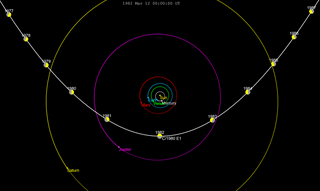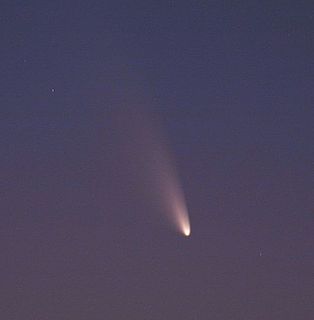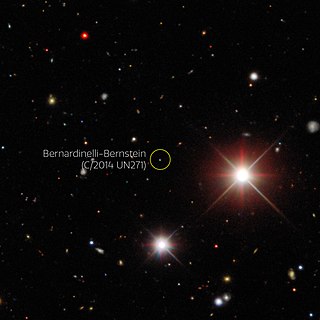10P/Tempel, also known as Tempel 2, is a periodic Jupiter-family comet with a 5 year orbital period. It was discovered on July 4, 1873 by Wilhelm Tempel. The next perihelion passage is 24 March 2021 when the comet will have a solar elongation of 30 degrees at approximately apparent magnitude 11. Closest approach to Earth during the 2021 passage will not occur until many months later on 3 November 2021 at a distance of 1.6 AU (240 million km).

7P/Pons–Winnecke is a periodic Jupiter-family comet with a 6-year orbit. Early calculations for the 1921 apparition suggested that the orbit of the comet might collide with Earth in June, but observations on April 10 ruled out an impact. It made a very close approach to Earth in June 1927. The outward migration of perihelion created impressive meteor showers in 1916, 1921, and 1927.
Comet C/2006 M4 (SWAN) is a non-periodic comet discovered in late June 2006 by Robert D. Matson of Irvine, California and Michael Mattiazzo of Adelaide, South Australia in publicly available images of the Solar and Heliospheric Observatory (SOHO). These images were captured by the Solar Wind ANisotropies (SWAN) Lyman-alpha all-sky camera on board the SOHO. The comet was officially announced after a ground-based confirmation by Robert McNaught on July 12.

C/1980 E1 is a non-periodic comet discovered by Edward L. G. Bowell on 11 February 1980 and which came closest to the Sun (perihelion) in March 1982. It is leaving the Solar System on a hyperbolic trajectory due to a close approach to Jupiter. Since its discovery only 1I/ʻOumuamua and 2I/Borisov have been identified with a faster such trajectory.

94P/Russell 4 is a periodic comet in the Solar System. It fits the definition of an Encke-type comet with. It was discovered by Ken Rusell on photographic plates taken by M. Hawkins on March 7, 1984. In the discovery images, Russell estimated that the comet had an apparent magnitude of 13 and a noticeable tail of 5 arc minutes. In the year of discovery, the comet had come to perihelion in January 1984.
C/1999 F1 (Catalina) is one of the longest known long-period comets. It was discovered on March 23, 1999, by the Catalina Sky Survey. The current perihelion point is outside of the inner solar system which helps reduce planetary perturbations to this outer Oort cloud object.

C/2011 L4 (PANSTARRS) is a non-periodic comet discovered in June 2011 that became visible to the naked eye when it was near perihelion in March 2013. It was discovered using the Pan-STARRS telescope located near the summit of Haleakalā, on the island of Maui in Hawaii. Comet C/2011 L4 probably took millions of years to come from the Oort cloud. After leaving the planetary region of the Solar System, the post-perihelion orbital period is estimated to be roughly 107000 years. Dust and gas production suggests the comet nucleus is roughly 1 kilometer (0.62 mi) in diameter.

C/2012 K1 (PANSTARRS) is a retrograde Oort cloud comet discovered at magnitude 19.7, 8.7 AU from the Sun on 17 May 2012 using the Pan-STARRS telescope located near the summit of Haleakalā, on the island of Maui in Hawaii (U.S.).
2012 DR30 is a trans-Neptunian object and centaur from the scattered disk and/or inner Oort cloud, located in the outermost region of the Solar System. The object with a highly eccentric orbit of 0.99 was first observed by astronomers with the Spacewatch program at Steward Observatory on 31 March 2009. It measures approximately 188 kilometers (120 miles) in diameter.

2013 BL76 is a trans-Neptunian object and centaur from the scattered disk and Inner Oort cloud approximately 30 kilometers in diameter.
2013 AZ60 is a small Solar System body (extended centaur) from the scattered disk or inner Oort cloud. 2013 AZ60 has the 8th-largest semi-major axis of a minor planet not detected outgassing like a comet (2013 BL76, 2005 VX3 and 2012 DR30 have a larger semi-major axis).
2005 VX3 is trans-Neptunian object and retrograde damocloid on a highly eccentric, cometary-like orbit. It was first observed on 1 November 2005, by astronomers with the Mount Lemmon Survey at the Mount Lemmon Observatory in Arizona, United States. The unusual object measures approximately 7 kilometers (4 miles) in diameter. It has the 3rd largest known heliocentric semi-major axis and aphelion. Additionally its perihelion lies within the orbit of Jupiter, which means it also has the largest orbital eccentricity of any known minor planet.

C/2014 Q2 (Lovejoy) is a long-period comet discovered on 17 August 2014 by Terry Lovejoy using a 0.2-meter (8 in) Schmidt–Cassegrain telescope. It was discovered at apparent magnitude 15 in the southern constellation of Puppis. It is the fifth comet discovered by Terry Lovejoy. Its blue-green glow is the result of organic molecules and water released by the comet fluorescing under the intense UV and optical light of the Sun as it passes through space.
C/2012 S4 (PANSTARRS) is a non-periodic comet with the largest listed aphelion of any object on the JPL Small-Body Database. But the listed aphelion distance of 500,000 AU (8 ly) from the Sun is a generic near-perihelion unperturbed two-body solution that assumes the Sun and comet are the only two objects in the Universe. Other comets, such as C/2015 TQ209 (LINEAR) and C/2017 A3 (Elenin) have had epoch-dependent solutions with aphelia of more than 1,000,000 AU (16 ly). As a comparison, the closest star, Proxima Centauri, is about 4.24 light years from the Sun, and Wolf 359 is 7.78 light years away. Any comet more than about 150,000 AU (2 ly) from the Sun can be considered lost to the interstellar medium. Using an epoch when C/2012 S4 (PANSTARRS) is beyond the planetary region of the Solar System, it is clear C/2012 S4 (PANSTARRS) will not be ejected from the Solar System.

2014 FE72 is a trans-Neptunian object first observed on 26 March 2014, at Cerro Tololo Observatory, La Serena. It is a possible dwarf planet, a member of the scattered disc, whose orbit extends into the inner Oort cloud. Discovered by Scott Sheppard and Chad Trujillo, the object's existence was revealed on 29 August 2016. Both the orbital period and aphelion distance of this object are poorly constrained. 2014 FE72 had the largest barycentric aphelion until 2018. However, the heliocentric aphelion of 2014 FE72 is second among trans-Neptunian objects (after the damocloid 2017 MB7).

C/2017 K2 (PANSTARRS) is an Oort cloud comet with a hyperbolic orbit, discovered in May 2017 at a distance beyond the orbit of Saturn when it was 16 AU (2.4 billion km) from the Sun. Precovery images from 2013 were located by July. It has been in the constellation of Draco since July 2007. As of May 2021, the 3-sigma uncertainty in the current distance of the comet from the Sun is ±4,000 km (2,500 mi). The comet is record breaking because it is already becoming active at such a distance, only comet Hale Bopp produced such a show from that distance and having a similar nucleus. However, this comet will not be as visible as Hale Bopp was in 1997, although it will reach naked eye visibility on its perihelion. Astronomers have never seen an active inbound comet this far out, where sunlight is 1/225th its brightness as seen from Earth. Temperatures, correspondingly, are at a minus 440 degrees Fahrenheit (-262 °C) in the Oort cloud. However, as it is approaching the Sun at a distance of 16 AU at discovery, a mix of ancient ices on the surface of oxygen, nitrogen, carbon dioxide and carbon monoxide is beginning to sublimate and shed as dust. This material expands into a vast 130,000 km (81,000 mi) wide halo of dust, called a coma, enveloping the solid nucleus.

C/2017 U7 is a hyperbolic comet, first observed on 29 October 2017 by astronomers of the Pan-STARRS facility at Haleakala Observatory, Hawaii, United States when the object was 7.8 AU (1.2 billion km) from the Sun. Despite being discovered only 10 days after interstellar asteroid 1I/'Oumuamua, it was not announced until March 2018 as its orbit is not strongly hyperbolic beyond most Oort Cloud comets. Based on the absolute magnitude of 10.6, it may measure tens of kilometers in diameter. As of August 2018, there is only 1 hyperbolic asteroid known, ʻOumuamua, but hundreds of hyperbolic comets are known.

C/2017 T2 (PANSTARRS) is an Oort cloud comet discovered on 2 October 2017 when it was 9.2 AU (1.38 billion km) from the Sun. The closest approach to Earth was on 28 December 2019 at a distance of 1.52 AU (227 million km). It came to perihelion on 4 May 2020 when it was safe from disintegration at 1.6 AU from the Sun.

C/2014 UN271 (Bernardinelli-Bernstein) or simply 2014 UN271, is a potentially large Oort cloud comet discovered by astronomers Pedro Bernardinelli and Gary Bernstein in archival images from the Dark Energy Survey. When first imaged in October 2014, the object was 29 AU (4.3 billion km) from the Sun, almost as far as Neptune's orbit, and the greatest distance that a comet has been discovered. In 2021, it is approaching the Sun at a distance between 19 AU (2.8 billion km) and 21 AU (3.1 billion km) and will reach its perihelion of 10.9 AU (just outside of Saturn's orbit) in January 2031.




















